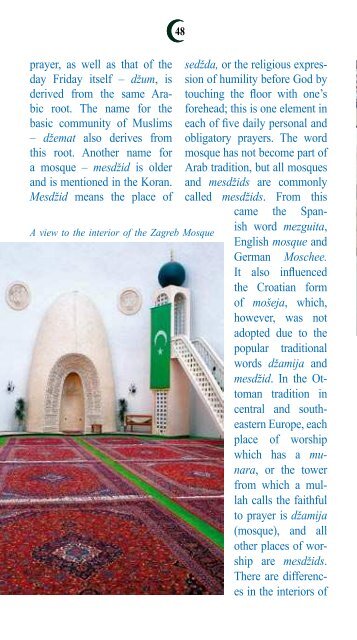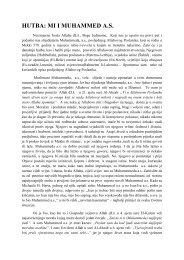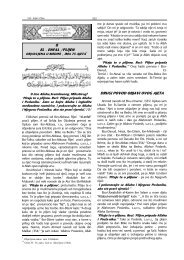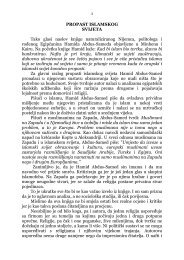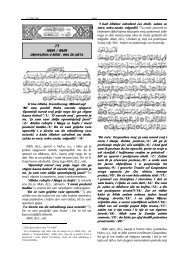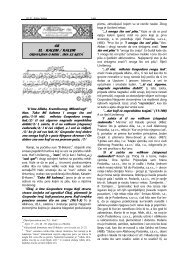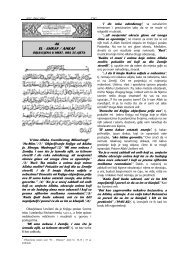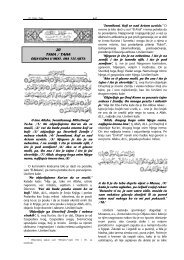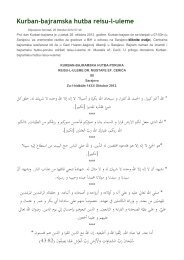ZAGREB MOSQUE - Islamska zajednica u Hrvatskoj
ZAGREB MOSQUE - Islamska zajednica u Hrvatskoj
ZAGREB MOSQUE - Islamska zajednica u Hrvatskoj
You also want an ePaper? Increase the reach of your titles
YUMPU automatically turns print PDFs into web optimized ePapers that Google loves.
prayer, as well as that of the<br />
day Friday itself – džum, is<br />
derived from the same Arabic<br />
root. The name for the<br />
basic community of Muslims<br />
– džemat also derives from<br />
this root. Another name for<br />
a mosque – mesdžid is older<br />
and is mentioned in the Koran.<br />
Mesdžid means the place of<br />
A view to the interior of the Zagreb Mosque<br />
<br />
sedžda, or the religious expression<br />
of humility before God by<br />
touching the floor with one’s<br />
forehead; this is one element in<br />
each of five daily personal and<br />
obligatory prayers. The word<br />
mosque has not become part of<br />
Arab tradition, but all mosques<br />
and mesdžids are commonly<br />
called mesdžids. From this<br />
came the Spanish<br />
word mezguita,<br />
English mosque and<br />
German Moschee.<br />
It also influenced<br />
the Croatian form<br />
of mošeja, which,<br />
however, was not<br />
adopted due to the<br />
popular traditional<br />
words džamija and<br />
mesdžid. In the Ottoman<br />
tradition in<br />
central and southeastern<br />
Europe, each<br />
place of worship<br />
which has a munara,<br />
or the tower<br />
from which a mullah<br />
calls the faithful<br />
to prayer is džamija<br />
(mosque), and all<br />
other places of worship<br />
are mesdžids.<br />
There are differences<br />
in the interiors of<br />
Hutba (preaching) on Friday<br />
mosques and mesdžids. Both<br />
of them have a mihrab, a niche<br />
in the front wall marking the<br />
obligatory direction for each<br />
common and personal prayer,<br />
which points to Mecca or a<br />
building called Bejtullah, the<br />
first of God’s houses erected<br />
by Ibrahim/Abraham, God’s<br />
emissary. Mosques also have<br />
a minber, a pulpit situated to<br />
the right of the mihrab, from<br />
which the imam addresses the<br />
faithful on Friday and on holy<br />
days, as was done by God’s<br />
emissary Mohammed. To the<br />
left of mihrab, there is ćurs,<br />
from the Arabian name for<br />
chair, from where lectures are<br />
delivered separate from the religious<br />
service. Mosques and<br />
mesdžids can have domes or<br />
roofs, they can have harems<br />
(fenced courtyards), mahfils<br />
(prayer galleries), šadrvans<br />
(fountains) and abdesthans<br />
(basins for ceremonial cleansing<br />
before prayer). There is a<br />
lot of varied mosque typology<br />
throughout history, and in the<br />
many cultures and civilizations<br />
of the Islamic world.


